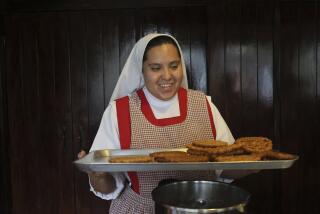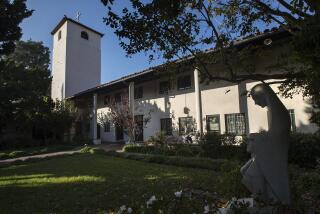11 W. German Monasteries Keep on Brewin’ : Monks Hop On Beer Bandwagon
- Share via
ETTAL, West Germany — Crucifixes hang on the walls over foaming vats of beer as monks and nuns in West Germany continue an enterprise that began in the Dark Ages.
“Beer is food in Bavaria,” said Brother Josef, a monk showing a visitor through the 400-year-old brewery at the Benedictine monastery in the Alpine hamlet of Ettal.
The Ettal monastery is one of 11 remaining West German monasteries in which light and dark beer has been brewed under licenses first issued in the middle of the 11th Century. Most are in the predominantly Roman Catholic state of Bavaria in southern Germany.
Hundreds of German monasteries pioneered brewing techniques that were later taken over by private brewers.
90% Sold Locally
Today, German monastery breweries are small by commercial standards, and more than 90% of their brew is sold only locally. But they have a few special-order customers elsewhere in Germany and abroad.
The Ettal monastery produces 260,000 gallons of beer and 52,000 gallons of sweet liqueur a year for customers ranging from a hotel in the village to a restaurant in Wisconsin.
It once was common for Roman Catholic monks or nuns to both brew their beer and pump it out of kegs for thirsty customers at rustic beer parlors, or braeustuebl , on the premises of the monasteries.
The beer parlors survive today, but only two monasteries--Franciscan convents at Mallersdorf and Ursberg--still have members actually working in the klosterbrauerei (cloister breweries).
Brewery Modernized
“My older brother was once the brewmaster here but now all seven of the workers are professional laymen,” said Brother Josef. He explained that the need for professional expertise rose as Germany’s cloister breweries were modernized after World War II.
Brother Josef is the financial overseer of the brewery, but does not work there. The general manager is Ettal’s abbot.
“We honor our tradition by brewing beer today, but it’s not our raison d’etre and we have no plans to expand,” said Brother Josef, 48, a monk since 1956.
The brewery supports about one-third of the Ettal monastery’s annual budget.
2 Million Gallons a Year
At the 550-year-old Franciscan monastery Andechs in the Alpine foothills southwest of Munich, almost 2 million gallons of beer are produced each year out of the best-known cloister brewery. About 1.2 million people a year imbibe at Andechs’ beer parlor.
At lunchtime on a recent day at Andechs, employees in green vests were tapping dark beer from ancient wooden barrels into huge, one-quart mugs selling for $2.30 each.
Stocky, ruddy-cheeked locals, many wearing Bavarian olive green sweaters or plumed hats, sat cradling their steins at old pine tables on unfinished wooden floors.
“Our beer has won friends from all over the world just through the soldiers stationed in our area,” said Brother Anselm, manager of the Andechs brewery.
Inconspicuous Breweries
Brewery buildings typically sit inconspicuously in the middle of the monastery, often sandwiched between a pink or white-hued abbey and the cloister’s beer parlor. The monasteries usually are ensconced on hills in the middle of their towns, the towers of their abbeys defining the communities’ skyline from a distance.
At the Mallersdorf cloister, about 55 miles northeast of Munich, strollers who peer through brewery windows can spot nuns grappling with cans of beer over steaming vats.
The oldest written evidence of cleric-run breweries dates to 1397, when a Nuremberg monk wrote of a klosterbrauerei in St. Gallen (now in Switzerland) in the 9th Century that contained kiln dryers, malt crushers, cooling, purifying and storehouses.
Monks at first envisioned beer solely as a hearty drink that would not clash with their fasting days. But it wasn’t long before beer was being offered to weary pilgrims and other travelers showing up at cloister doors.
About 950 years ago German monks started to develop lucrative commercial markets based on licenses issued by bishops or princes.
But in the Middle Ages, monastery brewing began its slow decline as private guild brewers grew in prominence and pressured their princes to ban public sales of monastery beer.
More to Read
Sign up for Essential California
The most important California stories and recommendations in your inbox every morning.
You may occasionally receive promotional content from the Los Angeles Times.













